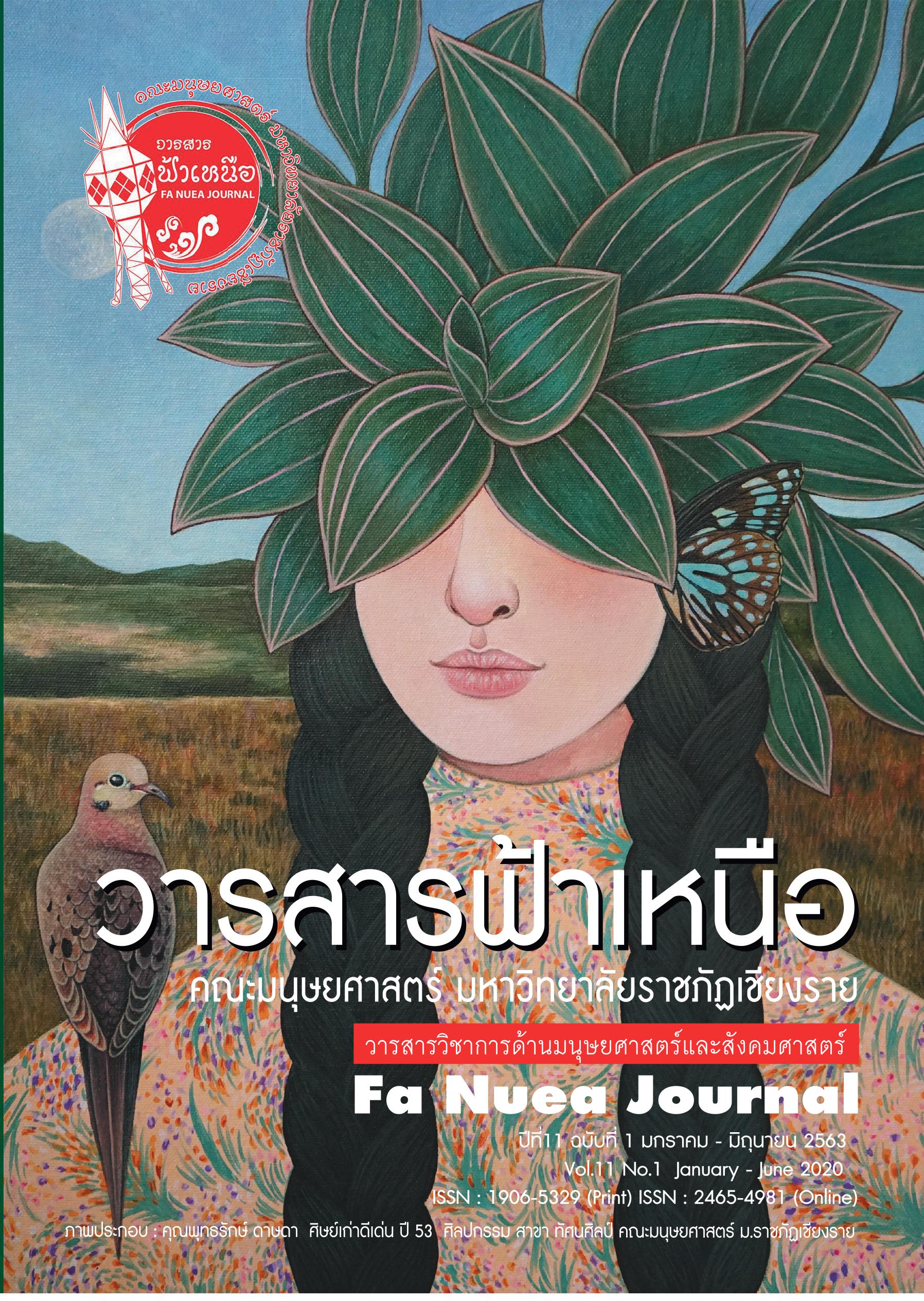ปัจจัยที่ส่งผลต่อความเข้าใจในการสื่อสารระหว่างวัฒนธรรมของ นักศึกษาจีนและชุมชนบริเวณโดยรอบของ มหาวิทยาลัยราชภัฏเชียงราย
Main Article Content
บทคัดย่อ
การวิจัยครั้งนี้มีวัตถุประสงค์เพื่อศึกษาปัจจัยที่ส่งผลต่อความเข้าใจในการสื่อสารระหว่างวัฒนธรรมของนักศึกษาจีนและชุมชนบริเวณของมหาวิทยาลัยราชภัฏเชียงราย และเพื่อศึกษาแนวทางในการพัฒนาการสื่อสารเพื่อเพิ่มความเข้าใจในการสื่อสารระหว่างวัฒนธรรมของนักศึกษามหาวิทยาลัยราชภัฏเชียงราย ประชากรที่ใช้ในการวิจัยครั้งนี้ ได้แก่ นักศึกษาจีน บุคลากรในมหาวิทยาลัยราชภัฏเชียงราย และประชาชนที่อาศัยอยู่บริเวณโดยรอบของมหาวิทยาลัยราชภัฏเชียงราย เครื่องมือในการเก็บรวบรวมข้อมูล ได้แก่แบบสอบถามข้อมูล เชิงลึกและข้อคำถามสัมภาษณ์ วิธีการวิเคราะห์ข้อมูลโดยนำข้อมูลที่ได้จากการสัมภาษณ์ มาจัดประเภท หมวดหมู่ และตีความเพื่อหาข้อสรุป โดยประยุกต์แนวคิดทฤษฎีการสื่อสารระหว่างวัฒนธรรม (InterculturalCommunication) ของ Gudykunst และ Kim (1997) และแนวคิดการปรับตัวทางวัฒนธรรม (Cultural Adaptation) ของ Berry (1997) และคณะมาเป็นกรอบในการวิเคราะห์ ผลการวิจัยพบว่า ลักษณะการสื่อสารระหว่างวัฒนธรรมของผู้ให้สัมภาษณ์ เป็นการสื่อสารสองทาง และการติดต่อสื่อสารแบบผ่านสิ่งสกัดกั้น เนื้อหาที่ติดต่อสื่อสาร ได้แก่ เรื่องปัญหาการเรียนการสอน ชีวิตความเป็นอยูส่่วนตัว และวัฒนธรรมต่างๆ ปัญหาที่พบในการสื่อสารระหว่างวัฒนธรรม คือปัญหาด้านความรู้ ด้านทัศนคติและด้านพฤติกรรม โดยปัจจัยที่ส่งผลต่อความเข้าใจในการสื่อสารระหว่างวัฒนธรรมเพื่อการปรับตัวข้ามวัฒนธรรม ได้แก่ปัจจัยด้านทัศนคติ ปัจจัยด้านภาษา ปัจจัยด้านวัฒนธรรม และปัจจัยด้านอื่นๆเช่น เพศชายและเพศหญิง อายุ ระยะเวลาที่พักอาศัยในชุมชนหรือในประเทศไทยและสิ่งอำนวยความสะดวกในการสื่อสารระหว่างวัฒนธรรม เป็นต้น
Article Details

อนุญาตภายใต้เงื่อนไข Creative Commons Attribution-NonCommercial-NoDerivatives 4.0 International License.
เนื้อหาและข้อมูลในบทความที่ลงตีพิมพ์ในวารสารฟ้าเหนือระบบ ThaiJO2 ถือเป็นข้อคิดเห็นและความรับผิดชอบของบทความโดยตรงซึ่งกองบรรณาธิการวารสารไม่จำเป็นต้องเห็นด้วยหรือร่วมรับผิดชอบใด ๆ
บทความ ข้อมูล เนื้อหา รูปภาพ ฯลฯ ที่ได้รับการตีพิมพ์ในวารสารฟ้าเหนือระบบ ThaiJO2 ถือเป็นลิขสิทธิ์ของ วารสารฟ้าเหนือระบบ ThaiJO2 หากบุคคลหรือหน่วยงานใดต้องการนำทั้งหมดหรือส่วนหนึ่งส่วนใดไปเผยแพร่ต่อ หรือเพื่อกระทำการใดๆจะต้องได้รับอนุญาตเป็นลายลักษณ์อักษรจากวารสารฟ้าเหนือระบบ ThaiJO2 ก่อนเท่านั้น
เอกสารอ้างอิง
กริช สืบสนธิ์ (2538). วัฒนธรรมและพฤติกรรมการสื่อสารในองค์กร. พิมพ์ครั้งที่ 2. กรุงเทพฯ: โรงพิมพ์จุฬาลงกรณ์มหาวิทยาลัย.
ฉัตรระวี สุคนธรัตน์. (2542). บทบาทในการสื่อสารระหว่างประเทศของนักการฑูต. (วิทยานิพนธ์นิเทศศาสตรมหาบัณฑิต). จุฬาลงกรณ์มหาวิทยาลัย. กรุงเทพมหานคร.
ธานิษฏ์ กองแก้ว. (2544). การสื่อสารและการปรับตัวของอาจารย์ต่างชาติในมหาวิทยาลัย. (วิทยานิพนธ์นิเทศศาสตรมหาบัณฑิต). จุฬาลงกรณ์มหาวิทยาลัย. กรุงเทพมหานคร.
รัตนาพร แสนใหญ่. (2554). รูปแบบการสนทนาเพื่อการสื่อสารระหว่างอาจารย์สอนภาษาไทยกับนักศึกษาจีน ที่เรียนภาษาไทยเป็นภาษาที่สองของศูนย์การสอนภาษาไทยสำหรับชาวต่างประเทศ มหาวิทยาลัยราชภัฏเชียงราย. (วิทยานิพนธ์ศิลปศาสตรมหาบัณฑิต).มหาวิทยาลัยราชภัฏเชียงราย. เชียงราย.
ภัทรานุจ แสงจันทร์. (2542). สถานภาพการศึกษาวิจัยทางการสื่อสารระดับวัฒนธรรมในประเทศไทย. (วิทยานิพนธ์นิเทศศาสตรมหาบัณฑิต).จุฬาลงกรณ์มหาวิทยาลัย. กรุงเทพมหานคร.
เมตตา วิวัฒนานุกูล. (2548). การสื่อสารระหว่างวัฒนธรรม. พิมพ์ครั้งที่ 1. กรุงเทพมหานคร: จุฬาลงกรณ์มหาวิทยาลัย.
วราภรณ์ อวิรุทธ์วรกุล. (2558). กระบวนการสื่อสารระหว่างวัฒนธรรมของนักศึกษาไทยในประเทศจีนตอนใต้. (ปริญญานิเทศศาสตรมหาบัณฑิต).มหาวิทยาลัยนเรศวร.
หวง จิ้น เอี๋ยน. (2544). การสอนภาษาไทยในประเทศจีน. วารสารมนุษย์ศาสตร์ปริทรรศน์ 23 (ประจำภาคเรียนที่หนึ่ง – สอง 2544)
Berry, J.W., Sam. D. (1997). Acculturation and adaptation. In J.W.Berry, M.H. stress. International Migration Review, 21, 491-511.
Gudykunstand, W. B. & Kim Y.Y. (1997). Communicating withStrangers : An Approach to Intercultural communication.New York : McGraw-Hill.
Hall, E.T. (1976). Beyond Culture. Garden City, NY: Anchor.Leed-Hurwitz. (1990). Notes in the history of Intercultural communication : The foreign service institute and the mandate for Intercultural traing. Quarterly Journal of Speech, 76(262-281)
Lustig and Koester. (1993). Intercultural communication : Interpersonal across culture.
New York : Herper Collions College.


